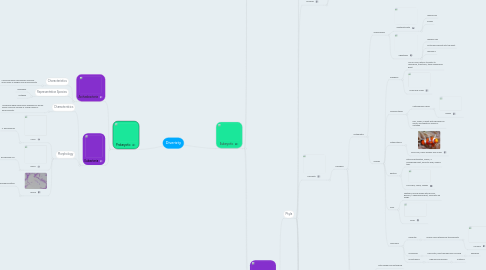
1. Eukaryotic
1.1. Protista
1.1.1. Characteristics
1.1.1.1. Live in water, can be multicellular and unicellular and can be heterotrophic or autotrophic
1.1.2. Feeding Strategy
1.1.2.1. Heterotrophic
1.1.2.1.1. Obtains their energy from other sources
1.1.2.2. Autotrophic
1.1.2.2.1. Creates their own energy
1.1.3. Animal Like Phyla
1.1.3.1. Movement Strategy
1.1.3.1.1. Sarcodine - Pseudopods
1.1.3.1.2. Ciliates-Cilia
1.1.3.1.3. Zooflagellates-Flagella
1.1.4. Plant Like Phyla
1.1.4.1. Chlorophyta
1.1.4.1.1. Green algae-Volvox
1.1.4.2. Phaeophyta
1.1.4.2.1. Brown algae-macrocystis
1.1.4.3. Chrysophyta
1.1.4.3.1. Diatoms-Cyclotella
1.1.4.4. Pyrrophyta
1.1.4.4.1. Dinoflagellates-Gonyaulax
1.1.4.5. Euglenophyta
1.1.4.5.1. Euglenoids-Euglena
1.1.4.6. Rhodophyta
1.1.4.6.1. Red algae-Porphyra
1.1.5. Fungus Like Phyla
1.1.5.1. Molds
1.1.5.1.1. Saprophytic heterotrophs- digesting their food externally and then absorbing it
1.1.5.1.2. Types
1.2. Plantae
1.2.1. Characteristics
1.2.1.1. Multicellular and stationary, autotrophic-photosynthetic develop from embryos and alterations of generations for reproduction
1.2.2. Classifications
1.2.2.1. Vascular
1.2.2.1.1. Tracheophytes
1.2.2.2. Non- Vascular
1.2.2.2.1. Hornworts and Mosses
1.2.2.2.2. Non-Tracheophytes
1.2.3. Evolutionary Transition
1.2.3.1. Stand Upright
1.2.3.2. Reproductive Strategies
1.2.3.3. Waxy coating, cuticle and stomata appeared to prevent moisture loss
1.2.3.4. Conducting tissues for moving nutrients and waste
1.2.3.4.1. Phloem
1.2.3.4.2. Xylem
1.3. Animalia
1.3.1. Phyla
1.3.1.1. Prorifera
1.3.1.1.1. Sponges
1.3.1.1.2. Filter feed through water
1.3.1.2. Cnidaria
1.3.1.2.1. Major Groups
1.3.1.2.2. Characterictics
1.3.1.3. Annelids
1.3.1.3.1. Earthworms
1.3.1.3.2. Segmented worms, bilateral symmetry, coelomate and triploblastic
1.3.1.4. Chordata
1.3.1.4.1. Subphyla
1.3.1.5. Nematoda
1.3.1.5.1. Round Worms
1.3.1.5.2. Characteristics
1.3.1.6. Echinodermata
1.3.1.6.1. Radial symmetry, no terrestrial representatives nor freshwater
1.3.1.6.2. Starfish
1.3.1.7. Platyhelminthes
1.3.1.7.1. Characteristics
1.3.1.7.2. Flatworms
1.3.1.8. Arthopoda
1.3.1.8.1. Subphylas
1.3.1.8.2. Characteritics
1.3.1.9. Mollusca
1.3.1.9.1. Classes
1.3.2. Evolutionary Milestone
1.3.2.1. Sponges
1.3.2.1.1. Multicellularity
1.3.2.2. Nematoda
1.3.2.2.1. Body Cavity
1.3.2.3. Platyhelminthes
1.3.2.3.1. Bilateral Symmetry
1.3.2.4. Cnidarians
1.3.2.4.1. Tissues
1.3.2.5. Echinoderms
1.3.2.5.1. Deuterostomes
1.3.2.6. Annelids
1.3.2.6.1. Segmentation
1.3.2.7. Arthorpods
1.3.2.7.1. Jointed Appendages
1.3.2.8. Chordates
1.3.2.8.1. Notocord
1.3.2.9. Mullusks
1.3.2.9.1. Coelom
1.3.3. Characterics
1.3.3.1. Multicellular while lacking cell walls, heterotrophic, motile at some point in their life cycle and form a hollow ball of cycles called blastula during embryonic stages.
1.3.4. Adaptations for land conquest
1.3.4.1. Arthopods
1.4. Fungi
1.4.1. Characteristics
1.4.1.1. Stationary and multicellular, heterotrophic and have nuclei, work in the ecosystem to decompose, recycle nutrients and soil maintenance
1.4.2. Reproductive Strategies
1.4.2.1. Sexual
1.4.2.1.1. Spores germinate, mycelium is then formed, plasmogamy occurs and cytoplasm fusses, then moves to the heterokaryotic stage, fusion in the nuclei causes zygotes to form then meiosis occurs.
1.4.2.2. Asexual
1.4.2.2.1. The breakage of the hyphae releases spores Spores are haploids which germinate and mycelium is produced
1.4.3. Phylas
1.4.3.1. Zygomycota
1.4.3.1.1. Sexual Spore
1.4.3.2. Chytridiomycota
1.4.3.2.1. Flagellated Spores
1.4.3.3. Basidiomycota
1.4.3.3.1. Basidium contains sexual spores
1.4.3.4. Ascomycota
1.4.3.4.1. Asci contains sexual spores
2. Prokaryotic
2.1. Archaebacteria
2.1.1. Characteristics
2.1.1.1. Unicellular while reproduces asexually and survive in oxygen-free environments
2.1.2. Representative Species
2.1.2.1. Halophiles
2.1.2.2. Methane
2.2. Eubacteria
2.2.1. Characteristics
2.2.1.1. Unicellular while reproduces asexually by binary fission and may survive in a wide range of environments.
2.2.2. Morphology
2.2.2.1. Cocci
2.2.2.1.1. S. pneumoniae
2.2.2.2. Bacilli
2.2.2.2.1. Escherichia coli
2.2.2.3. Spirilla
2.2.2.3.1. Chlamydophila psittaci
